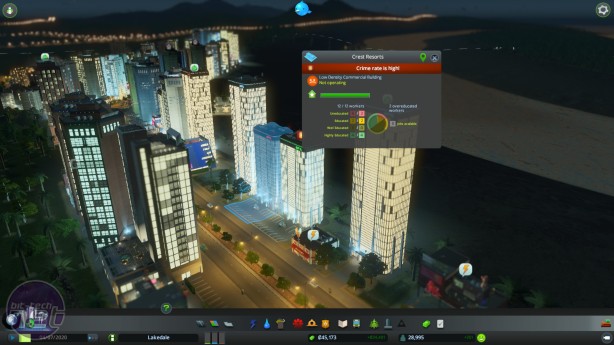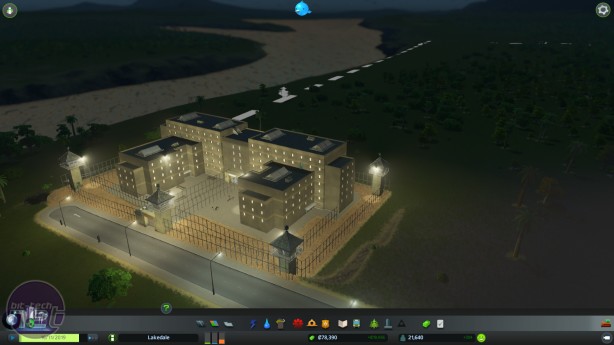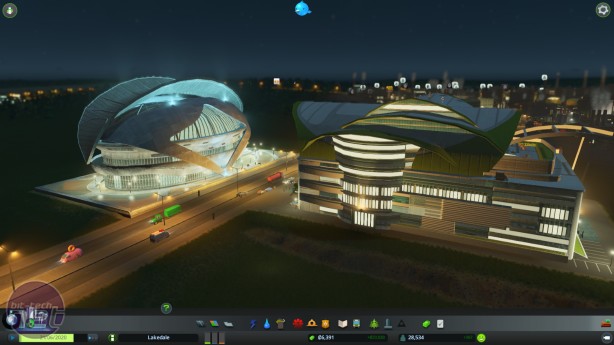Cities Skylines: After Dark Review
September 25, 2015 | 09:49
Companies: #colossal-order #maxis #paradox-interactive

In my city, I purchased a new plot of land and used it to create a nightmarish combination of Benidorm and the Las Vegas Strip. Here a long four-lane street lined with nightclubs, casinos and bars led to a snakelike road that curved along a sandy shoreline, where the sky was punctured by dozens of concrete tourist traps. I then lined the seafront with a range of beach attractions, a fishing pier, a beach volleyball court, a boat-tour operator.
These specialised commercial zones have a dramatic effect on the look of your city, as they're often interspersed within residential and traditional commercial zones rather than kept at a safe distance as is the case with industry. They also affect your approach to transportation. You want to be drawing both tourists and residents to these areas in order to help them thrive, which means ensuring strong transportation links.
In this area After Dark is also an impressive step forward from the vanilla game. It introduces new road-types that include bus and cycle lanes, and you can build paved pathways designed specifically for pedestrians and cyclists. The former are useful ways of managing traffic, the latter somewhat awkward to blend with the road network. Vehicular transport is expanded with a new taxi service to ferry all your freshly inebriated citizens home in the morning, and a bus terminal which, strangely, went entirely ignored when I placed it in my city. Lastly, After Dark introduces a massive international airport as a crowning glory for your transport aspirations, assuming you can find a place to put the damned thing.
Other new structures include a prison for rehabilitating convicted criminals and a riding stable to provide your most affluent areas with that vital smell of horse dung. In short, the expansion focuses on making your city a more entertaining place to be, and ensuring that you can effectively channel your populace to these new attractions.
The variety that After Dark adds is undoubtedly welcome. But the expansion doesn't make any fundamental changes to how the Skylines plays. Challenge-wise the game is much the same - fairly light. Any recurring problems your city encounters are usually to do with traffic flow and supporting your industries, and even these don't have any major impact unless you completely neglect them. Past a certain point your city's growth pretty much takes on a life of its own, and you never have to worry about money again. There are some new sliders to play with to take advantage of your city's nightlife, but by the time you've got you leisure zones built up, the cash is rolling in like the tide anyway.
The expansion also fails to address some of the more tedious busywork involved in cityscaping, like manually connecting every area to water pipes and electricity pylons. I also encountered a bug that offset placement of water-based buildings like the aquatic wind-turbines and water-pylons, which was particularly annoying given my city relied almost exclusively on wind power.
Nevertheless, After Dark is a fine example of expansion design, and is especially impressive given how the modding scene already offers an abundance of extra content for the game. It's a shame that the game's visual exploration of a city's darker side isn't really represented in the systems, but the new commercial zones and expanded transport network definitely justify the entry fee.
These specialised commercial zones have a dramatic effect on the look of your city, as they're often interspersed within residential and traditional commercial zones rather than kept at a safe distance as is the case with industry. They also affect your approach to transportation. You want to be drawing both tourists and residents to these areas in order to help them thrive, which means ensuring strong transportation links.
In this area After Dark is also an impressive step forward from the vanilla game. It introduces new road-types that include bus and cycle lanes, and you can build paved pathways designed specifically for pedestrians and cyclists. The former are useful ways of managing traffic, the latter somewhat awkward to blend with the road network. Vehicular transport is expanded with a new taxi service to ferry all your freshly inebriated citizens home in the morning, and a bus terminal which, strangely, went entirely ignored when I placed it in my city. Lastly, After Dark introduces a massive international airport as a crowning glory for your transport aspirations, assuming you can find a place to put the damned thing.
Other new structures include a prison for rehabilitating convicted criminals and a riding stable to provide your most affluent areas with that vital smell of horse dung. In short, the expansion focuses on making your city a more entertaining place to be, and ensuring that you can effectively channel your populace to these new attractions.
The variety that After Dark adds is undoubtedly welcome. But the expansion doesn't make any fundamental changes to how the Skylines plays. Challenge-wise the game is much the same - fairly light. Any recurring problems your city encounters are usually to do with traffic flow and supporting your industries, and even these don't have any major impact unless you completely neglect them. Past a certain point your city's growth pretty much takes on a life of its own, and you never have to worry about money again. There are some new sliders to play with to take advantage of your city's nightlife, but by the time you've got you leisure zones built up, the cash is rolling in like the tide anyway.
The expansion also fails to address some of the more tedious busywork involved in cityscaping, like manually connecting every area to water pipes and electricity pylons. I also encountered a bug that offset placement of water-based buildings like the aquatic wind-turbines and water-pylons, which was particularly annoying given my city relied almost exclusively on wind power.
Nevertheless, After Dark is a fine example of expansion design, and is especially impressive given how the modding scene already offers an abundance of extra content for the game. It's a shame that the game's visual exploration of a city's darker side isn't really represented in the systems, but the new commercial zones and expanded transport network definitely justify the entry fee.
-
Overall70 / 100


MSI MPG Velox 100R Chassis Review
October 14 2021 | 15:04













Want to comment? Please log in.